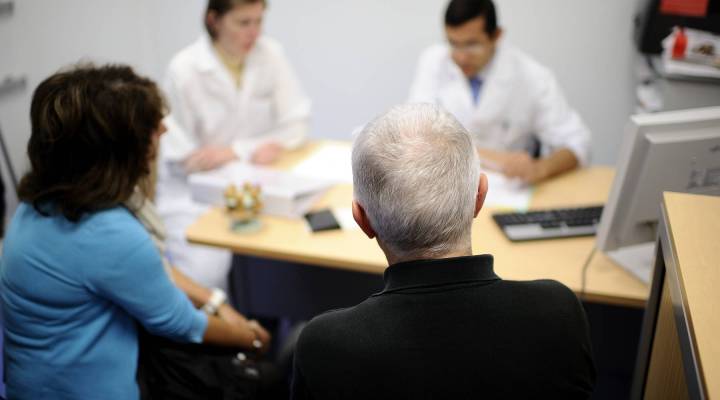
Doctors cut costs by getting to know their patients

The healthcare landscape is changing, even as Obamacare bumps along.
In the past six years, we’ve seen the rise of Accountable Care Organizations, now numbering more than 800, where doctors or hospitals work together to streamline care. For physicians that means they now get some compensation through contracts that reward improving health and controlling costs, as opposed to simply making money for every service provided regardless of the outcome or expense.
There are now an estimated 28 million Americans enrolled in these ACOs, and that means, at least for some, their care looks radically different than even just a few years ago. That’s particularly true for some of the sicker people in the country.
People like 76-year-old Millard Scott.
Scott, who lives in the small town of Williamson, West Virginia, population 3,000, suffers from Chronic Obstructive Pulmonary Disease. When his COPD kicks up, struggling to breathe is Scott’s big problem.
76-year old Millard Scott who suffers from COPD and community health worker Nurse Samantha Runyon.
Last year it got so bad, you could’ve just called him ‘Mr. Saturday’ since that was the day he kept showing up at the ER.
“He was going sometimes two to three times a week,” Scott’s primary care physician, Dr. Dino Beckett, said. This year, Beckett joined with nearly a dozen other primary care practices in the state and formed the Aledade West Virginia ACO. And because of that he now keeps detailed tabs on his patients.
When the ACO launched, Scott was Beckett’s 13th most expensive patient, with Medicare spending $36,000 on his care, most of that for the ER and hospital. The challenge for Beckett and other doctors now in ACO’s is to find ways to keep patients out of the emergency room and the hospital by keeping them healthy.
“What we’re trying to do is really just change the mindset and allow patients to understand they have access to us,” he said.
Beckett’s increasing that access in part by hiring a team of community health workers, including nurse Samantha Runyon. Her job has been to get to know patients like Scott, and understand their lives outside the world of healthcare. As providers get more familiar with patients at home, they have discovered people who regularly end up in the emergency room or the hospital are not only sick, but have home issues that exacerbate their conditions.
It takes getting up close and personal into someone’s life to know what the mystery trigger is.
It took nurse Runyon four visits to figure out what was lurking beneath the surface for Scott.
“So I get down there and I go in and he’s kinda struggling breathing and I go ‘what’s happened to you today,'” she said. “And he’s like ‘I got up and had a bad morning.'”
Scott lives in his daughter’s house. And he told Runyon he felt bad because he spilled a cup of coffee. Putting a number of pieces together, Runyon realized on top of COPD and diabetes, Scott also struggled with anxiety. And when he gets anxious he starts gulping for air, which quickly becomes a vicious cycle.
The good news was that just sitting and talking with Scott helped calm him down. So she and Dr. Beckett hatched the kind of plan you would rarely see a few years back.
They gave Scott a “green light” to see his doctors without an appointment, to put in a standing order at the hospital to get COPD treatment as needed and on top of Runyon’s weekly visits, Beckett said he gets a call every Friday.
“There is so much more interaction,” Beckett said. “Now we are reaching out to him to try to head off situations that can be very ominous for him.”
Five months later, Scott said he feels better.
His doctors said they’ve avoided a couple dozen trips to ER, and Scott has gone from 13th most expensive patient to the 30th, on track to spent $16,000 less than last year.
“He feels the change, we feel the change. And [the Center for Medicare and Medicaid Services] is seeing the change,” Beckett said.
“That is a wonderful story. We have saved money. We have improved someone’s health,” said Harvard economist Michael Chernew, who studies ACOs. “But when you add it all up, it ends up being less dramatic than the best case scenarios that story represents.”
When ACOs hit the scene around 2010, people hoped they’d cut spending by 30 percent. Chernew said the best data show these efforts have saved more like somewhere between 2 and 10 percent, primarily because hands-on care isn’t a cure-all.
But experiences like Scott’s are teaching us, when a patient has someone they can trust — a nurse, a home health aid, someone like Samantha Runyon — change can happen. Scott has seen it with his own eyes.
“If I know [Runyon’s] coming, I can sit here and make it through it. But if there wasn’t somebody I could depend on, I wouldn’t have even sat here. I would go to the ER,” he said. “But I know she’s coming.”
Read part two in our series on how health care, in the wake of the Affordable Care Act, is changing the lives of patients and doctors.
There’s a lot happening in the world. Through it all, Marketplace is here for you.
You rely on Marketplace to break down the world’s events and tell you how it affects you in a fact-based, approachable way. We rely on your financial support to keep making that possible.
Your donation today powers the independent journalism that you rely on. For just $5/month, you can help sustain Marketplace so we can keep reporting on the things that matter to you.


















